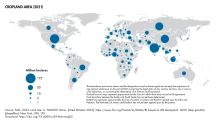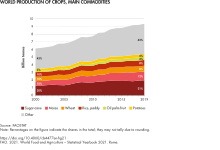Crop


A crop is a plant that can be grown and harvested extensively for profit or subsistence.[1] In other words, a crop is a plant or plant product that is grown for a specific purpose such as food, fibre, or fuel.
When plants of the same species are cultivated in rows or other systematic arrangements, it is called crop field or crop cultivation.
Most crops are harvested as food for humans or fodder for livestock.
Important non-food crops include horticulture, floriculture, and industrial crops. Horticulture crops include plants used for other crops (e.g. fruit trees). Floriculture crops include bedding plants, houseplants, flowering garden and pot plants, cut cultivated greens, and cut flowers. Industrial crops are produced for clothing (fiber crops e.g. cotton), biofuel (energy crops, algae fuel), or medicine (medicinal plants).
Production
[edit]


The production of primary crops was 9.5 billion tonnes in 2021, 54% more than in 2000. Four crops account for about half of global primary crop production: sugar cane, maize, wheat and rice.[3]
The global production of primary crops increased by 54% between 2000 and 2021, to 9.5 billion tonnes, which is 2% higher than in 2020. This represents 3.3 billion tonnes more than in 2000. With slightly less than one-third of the total, cereals were the main group of crops produced in 2021, followed by sugar crops (22%), vegetables and oil crops (12% each). Fruit, and roots and tubers each accounted for 9–10% of the total production. The increase in production is mostly attributable to a combination of factors; increased use of irrigation, pesticides and fertilizers, and to a lesser extent a larger cultivated area. Other factors such as better farming practices and the use of high-yield crops also play a role.[3]
The value of primary crops production increased at a slightly higher pace in real terms as the quantities produced (57%), from USD 1.8 trillion in 2000 to USD 2.8 trillion in 2021. As with quantities produced, cereals accounted for the largest share of the total production value in 2021 (30%). Vegetables and fruit represented 19% and 17%, respectively, of the total value in 2021, which is significantly higher than the shares in quantities. The shares of oil crops and roots and tubers in the total value were similar to the shares in quantities. Sugar crops represented 4% of the total value: such a discrepancy with the share of the quantities produced is due to differences in price compared to fruit and vegetables, and to the fact that the transformation into refined sugar is adding the most value.[3]
Globally important crops
[edit]The importance of a crop varies greatly depending on the region. Globally, the following crops contribute most to human food supply (values of kcal/person/day for 2013 given in parentheses): rice (541 kcal), wheat (527 kcal), sugarcane and other sugar crops (200 kcal), maize (corn) (147 kcal), soybean oil (82 kcal), other vegetables (74 kcal), potatoes (64 kcal), palm oil (52 kcal), cassava (37 kcal), legume pulses (37 kcal), sunflower seed oil (35 kcal), rape and mustard oil (34 kcal), other fruits, (31 kcal), sorghum (28 kcal), millet (27 kcal), groundnuts (25 kcal), beans (23 kcal), sweet potatoes (22 kcal), bananas (21 kcal), various nuts (16 kcal), soybeans (14 kcal), cottonseed oil (13 kcal), groundnut oil (13 kcal), yams (13 kcal).[4] Note that many of the globally apparently minor crops are regionally very important. For example, in Africa, roots & tubers dominate with 421 kcal/person/day, and sorghum and millet contribute 135 kcal and 90 kcal, respectively.[4]

In terms of produced weight, the following crops are the most important ones (global production in thousand metric tonnes):[5]
| Crop | 2000 | 2013 | 2020 |
|---|---|---|---|
| Sugarcane | 1,256,380 | 1,877,110 | 1,870,246 |
| Maize | 592,479 | 1,016,740 | 1,171,332 |
| Rice | 599,355 | 745,710 | 1,264,410 |
| Wheat | 585,691 | 713,183 | 760,931 |
| Potato | 327,600 | 368,096 | 359,124 |
Methods of cropping and popular crops in the U.S.
[edit]There are various methods of cropping that are used in the agricultural industry,[6] such as mono cropping, crop rotation, sequential cropping, and mixed intercropping.[7] Each method of cropping has its purposes and possibly disadvantages as well.[7] Himanshu Arora defines mono cropping as where a field only grows one specific crop year round.[6] Mono Cropping has its disadvantages, according to Himanshu Arora, such as the risk of the soil losing its fertility.[8] Following mono cropping, another method of cropping is relay cropping. According to the National Library of Medicine, relay cropping may solve a number of conflicts such as inefficient use of available resources, controversies in sowing time, fertilizer application, and soil degradation.[9] The result coming from the use of relay cropping is higher crop output.[9] In the United States, corn is the largest crop produced, and soybean follows in second, according to the government of Alberta.[10] Referring to a map given by the Government of Alberta, the most popular region to grow these popular crops is in the inner states of the U.S., it is where the crops are most successful in output.[10]
See also
[edit]- General topics and economics
- Floriculture crops
- Guerrilla gardening
- Management practices
- Cover crop
- Crop destruction
- Crop residue
- Crop rotation
- Crop weed
- Kharif crops (crops specific to South Asia)
- Nurse crop
- Rabi crops (crops specific to South Asia)
- Genetic diversity
- Origin
References
[edit]- ^ "crop". Merriam-Webster.com Dictionary. Merriam-Webster. Retrieved 2017-06-20.
- ^ a b World Food and Agriculture – Statistical Yearbook 2021. 2021. doi:10.4060/cb4477en. ISBN 978-92-5-134332-6. S2CID 240163091. Archived from the original on 2021-11-03. Retrieved 2021-12-13.
{{cite book}}:|website=ignored (help) - ^ a b c World Food and Agriculture – Statistical Yearbook 2023 | FAO | Food and Agriculture Organization of the United Nations. 2023. doi:10.4060/cc8166en. ISBN 978-92-5-138262-2. Retrieved 2023-12-13.
{{cite book}}:|website=ignored (help) - ^ a b Food and Agriculture Organization of the United Nations, Statistics Division (2017). "FAOstats Food Supply - Crops Primary Equivalent".
- ^ FAO 2015. FAO Statistical Pocketbook 2015, ISBN 978-92-5-108802-9, p. 28
- ^ a b Arora, Himanshu (2017-10-06). "Types of Cropping Systems: Mono cropping; Crop Rotation; Sequential Cropping; Inter Cropping; Relay Cropping".
- ^ a b "Types of Cropping Systems: Mono cropping; Crop Rotation; Sequential Cropping; Inter Cropping; Relay Cropping - Civilsdaily". 2017-10-06. Retrieved 2022-12-06.
- ^ "Types of Cropping Systems: Mono cropping; Crop Rotation; Sequential Cropping; Inter Cropping; Relay Cropping - Civilsdaily". 2017-10-06. Retrieved 2022-12-16.
- ^ a b Tanveer, Mohsin; Anjum, Shakeel Ahmad; Hussain, Saddam; Cerdà, Artemi; Ashraf, Umair (March 2017). "Relay cropping as a sustainable approach: problems and opportunities for sustainable crop production". Environmental Science and Pollution Research International. 24 (8): 6973–6988. Bibcode:2017ESPR...24.6973T. doi:10.1007/s11356-017-8371-4. ISSN 1614-7499. PMID 28083744. S2CID 207283489.
- ^ a b "US Crops – Where Are They Grown?". www.alberta.ca. Retrieved 2022-12-16.
Sources
[edit]![]() This article incorporates text from a free content work. Licensed under CC BY-SA IGO 3.0 (license statement/permission). Text taken from World Food and Agriculture – Statistical Yearbook 2023, FAO, FAO.
This article incorporates text from a free content work. Licensed under CC BY-SA IGO 3.0 (license statement/permission). Text taken from World Food and Agriculture – Statistical Yearbook 2023, FAO, FAO.
Further reading
[edit]- Sleper, David A.; Poehlman, John M. (2006). Breeding Field Crops. Blackwell Publishing. ISBN 9780813824284. Retrieved December 5, 2011.
